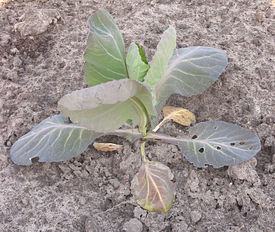- Nitrogen deficiency
-
- This is about nitrogen compounds in plant nutrition. For shortage of nitrogen compounds in human and animal nutrition, see protein deficiency.
All plants require sufficient supplies of macronutrients for healthy growth, and nitrogen (N) is a nutrient that is commonly in limited supply. Nitrogen deficiency in plants can occur when organic matter with high carbon carbon content, such as sawdust, is added to soil.[1] Soil organisms use any nitrogen to break down carbon sources, making N unavailable to plants.[1] This is known as "robbing" the soil of nitrogen. All vegetables apart from nitrogen fixing legumes are prone to this disorder.
Nitrogen deficiency can be prevented in the short term by using grass mowings as a mulch, or foliar feeding with manure, and in the longer term by building up levels of organic matter in the soil. Sowing green manure crops such as grazing rye to cover soil over the winter will help to prevent nitrogen leaching, while leguminous green manures such as winter tares will fix additional nitrogen from the atmosphere.
Detecting Nitrogen Deficiency
The visual symptoms of nitrogen deficiency mean that it can be relatively easy to detect in some plant species. Symptoms include poor plant growth, and leaves that are pale green or yellow because they are unable to make sufficient chlorophyll. Leaves in this state are said to be chlorotic. Lower leaves (older leaves) show symptoms first, since the plant will move nitrogen from older tissues to more important younger ones.[2]
However, these physical symptoms can also be caused by numerous other stresses, such as deficiencies in other nutrients, toxicity, herbicide injury, disease, insect damage or environmental conditions. Therefore, nitrogen deficiency is most reliably detected by conducting quantitative tests in addition to assessing the plants visual symptoms. These tests include soil tests and Plant tissue test.[3]
Plant tissue tests destructively sample the plant of interest. However, nitrogen deficiency can also be detected non-destructively by measuring chlorophyll content.
Chlorophyll content tests work because leaf nitrogen content and chlorophyll concentration are closely linked, which would be expected since the majority of leaf nitrogen is contained in chlorophyll molecules.[4] Chlorophyll content can be detected with a Chlorophyll content meter;[5] a portable instrument that measures the greenness of leaves to estimate their relative chlorophyll concentration.[6]
Chlorophyll content can also be assessed with a chlorophyll fluorometer, which measures a chlorophyll fluorescence ratio to identify phenolic compounds that are produced in higher quantities when nitrogen is limited.[7] These instruments can therefore be used to non-destructively test for nitrogen deficiency.
See also
References
- ^ a b http://whatcom.wsu.edu/ag/compost/fundamentals/needs_carbon_nitrogen.htm
- ^ http://www.rainbowplantfood.com/agronomics/efu/nitrogen.pdf
- ^ http://www.scribd.com/doc/15085476/CROP-NUTRIENT-DEFICIENCIES-TOXICITIES
- ^ http://digitalcommons.unl.edu/cgi/viewcontent.cgi?article=2349&context=extensionhist
- ^ http://www.adc.co.uk/Products/CCM-200_plus_Chlorophyll_Content_Meter
- ^ http://www.specmeters.com/pdf/Coffea%20canephora%20SPAD.pdf
- ^ http://www.adc.co.uk/bmt_mymedia/files/ADC_Product_Specification_OS5p.pdf
Boron deficiency | Calcium deficiency | Iron deficiency | Magnesium deficiency | Manganese deficiency | Nitrogen deficiency | Phosphorus deficiency | Potassium deficiency | Micronutrient deficiency
Categories:- Physiological plant disorders
- Nitrogen metabolism
- Plant disease stubs
Wikimedia Foundation. 2010.

